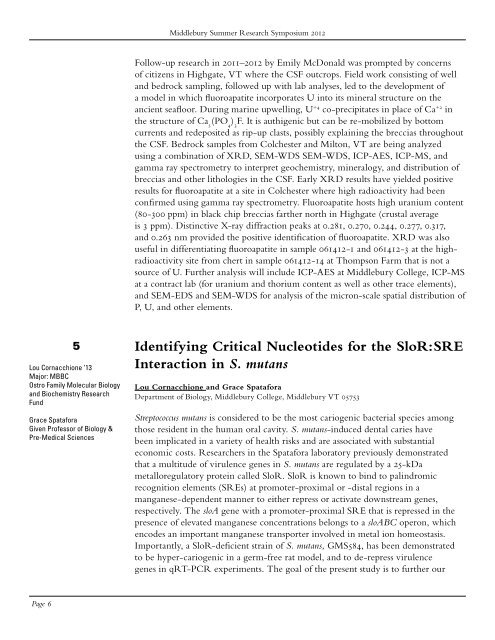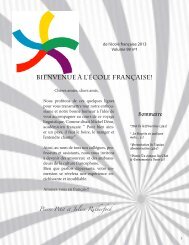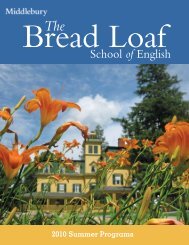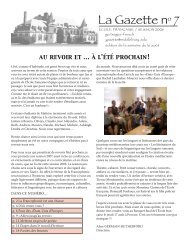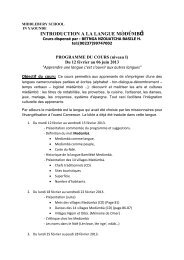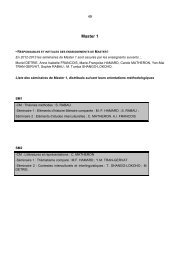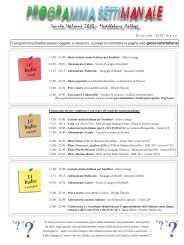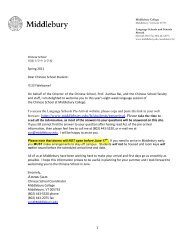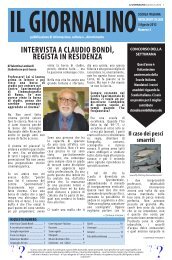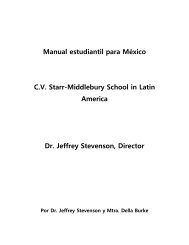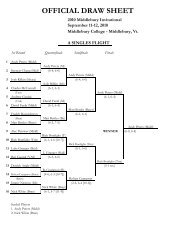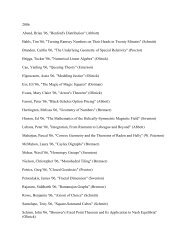2012 Summer Symposium Program - Middlebury College
2012 Summer Symposium Program - Middlebury College
2012 Summer Symposium Program - Middlebury College
Create successful ePaper yourself
Turn your PDF publications into a flip-book with our unique Google optimized e-Paper software.
Page 6<br />
5<br />
Lou Cornacchione ‘13<br />
Major: MBBC<br />
Ostro Family Molecular Biology<br />
and Biochemistry Research<br />
Fund<br />
Grace Spatafora<br />
Given Professor of Biology &<br />
Pre-Medical Sciences<br />
<strong>Middlebury</strong> <strong>Summer</strong> Research <strong>Symposium</strong> <strong>2012</strong><br />
Follow-up research in 2011–<strong>2012</strong> by Emily McDonald was prompted by concerns<br />
of citizens in Highgate, VT where the CSF outcrops. Field work consisting of well<br />
and bedrock sampling, followed up with lab analyses, led to the development of<br />
a model in which fluoroapatite incorporates U into its mineral structure on the<br />
ancient seafloor. During marine upwelling, U +4 co-precipitates in place of Ca +2 in<br />
the structure of Ca 5 (PO 4 ) 3 F. It is authigenic but can be re-mobilized by bottom<br />
currents and redeposited as rip-up clasts, possibly explaining the breccias throughout<br />
the CSF. Bedrock samples from Colchester and Milton, VT are being analyzed<br />
using a combination of XRD, SEM-WDS SEM-WDS, ICP-AES, ICP-MS, and<br />
gamma ray spectrometry to interpret geochemistry, mineralogy, and distribution of<br />
breccias and other lithologies in the CSF. Early XRD results have yielded positive<br />
results for fluoroapatite at a site in Colchester where high radioactivity had been<br />
confirmed using gamma ray spectrometry. Fluoroapatite hosts high uranium content<br />
(80-300 ppm) in black chip breccias farther north in Highgate (crustal average<br />
is 3 ppm). Distinctive X-ray diffraction peaks at 0.281, 0.270, 0.244, 0.277, 0.317,<br />
and 0.263 nm provided the positive identification of fluoroapatite. XRD was also<br />
useful in differentiating fluoroapatite in sample 061412-1 and 061412-3 at the highradioactivity<br />
site from chert in sample 061412-14 at Thompson Farm that is not a<br />
source of U. Further analysis will include ICP-AES at <strong>Middlebury</strong> <strong>College</strong>, ICP-MS<br />
at a contract lab (for uranium and thorium content as well as other trace elements),<br />
and SEM-EDS and SEM-WDS for analysis of the micron-scale spatial distribution of<br />
P, U, and other elements.<br />
Identifying Critical Nucleotides for the SloR:SRE<br />
Interaction in S. mutans<br />
Lou Cornacchione and Grace Spatafora<br />
Department of Biology, <strong>Middlebury</strong> <strong>College</strong>, <strong>Middlebury</strong> VT 05753<br />
Streptococcus mutans is considered to be the most cariogenic bacterial species among<br />
those resident in the human oral cavity. S. mutans-induced dental caries have<br />
been implicated in a variety of health risks and are associated with substantial<br />
economic costs. Researchers in the Spatafora laboratory previously demonstrated<br />
that a multitude of virulence genes in S. mutans are regulated by a 25-kDa<br />
metalloregulatory protein called SloR. SloR is known to bind to palindromic<br />
recognition elements (SREs) at promoter-proximal or -distal regions in a<br />
manganese-dependent manner to either repress or activate downstream genes,<br />
respectively. The sloA gene with a promoter-proximal SRE that is repressed in the<br />
presence of elevated manganese concentrations belongs to a sloABC operon, which<br />
encodes an important manganese transporter involved in metal ion homeostasis.<br />
Importantly, a SloR-deficient strain of S. mutans, GMS584, has been demonstrated<br />
to be hyper-cariogenic in a germ-free rat model, and to de-repress virulence<br />
genes in qRT-PCR experiments. The goal of the present study is to further our


